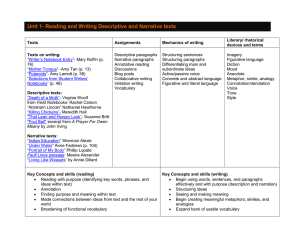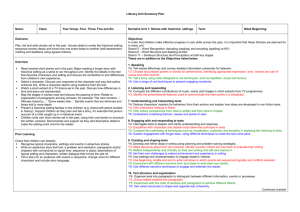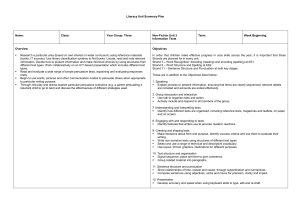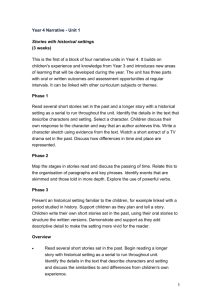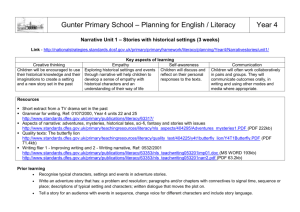Literacy Unit Summary Plan
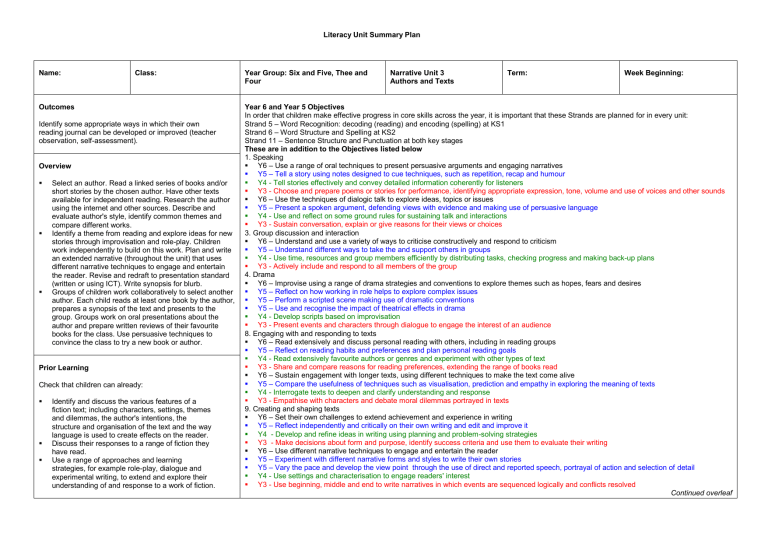
Literacy Unit Summary Plan
Name: Class:
Outcomes
Identify some appropriate ways in which their own reading journal can be developed or improved (teacher observation, self-assessment).
Overview
Select an author. Read a linked series of books and/or short stories by the chosen author. Have other texts available for independent reading. Research the author using the internet and other sources. Describe and evaluate author's style, identify common themes and compare different works.
Identify a theme from reading and explore ideas for new stories through improvisation and role-play. Children work independently to build on this work. Plan and write an extended narrative (throughout the unit) that uses different narrative techniques to engage and entertain the reader. Revise and redraft to presentation standard
(written or using ICT). Write synopsis for blurb.
Groups of children work collaboratively to select another author. Each child reads at least one book by the author, prepares a synopsis of the text and presents to the group. Groups work on oral presentations about the author and prepare written reviews of their favourite books for the class. Use persuasive techniques to convince the class to try a new book or author.
Prior Learning
Check that children can already:
Identify and discuss the various features of a fiction text; including characters, settings, themes and dilemmas, the author's intentions, the structure and organisation of the text and the way language is used to create effects on the reader.
Discuss their responses to a range of fiction they have read.
Use a range of approaches and learning strategies, for example role-play, dialogue and experimental writing, to extend and explore their understanding of and response to a work of fiction.
Year Group: Six and Five, Thee and
Four
Narrative Unit 3
Authors and Texts
Term: Week Beginning:
Year 6 and Year 5 Objectives
In order that children make effective progress in core skills across the year, it is important that these Strands are planned for in every unit:
Strand 5 – Word Recognition: decoding (reading) and encoding (spelling) at KS1
Strand 6 – Word Structure and Spelling at KS2
Strand 11 – Sentence Structure and Punctuation at both key stages
These are in addition to the Objectives listed below
1. Speaking
Y6 – Use a range of oral techniques to present persuasive arguments and engaging narratives
Y5 – Tell a story using notes designed to cue techniques, such as repetition, recap and humour
Y4 - Tell stories effectively and convey detailed information coherently for listeners
Y3 - Choose and prepare poems or stories for performance, identifying appropriate expression, tone, volume and use of voices and other sounds
Y6
– Use the techniques of dialogic talk to explore ideas, topics or issues
Y5 – Present a spoken argument, defending views with evidence and making use of persuasive language
Y4 - Use and reflect on some ground rules for sustaining talk and interactions
Y3 - Sustain conversation, explain or give reasons for their views or choices
3. Group discussion and interaction
Y6
– Understand and use a variety of ways to criticise constructively and respond to criticism
Y5 – Understand different ways to take the and support others in groups
Y4 - Use time, resources and group members efficiently by distributing tasks, checking progress and making back-up plans
Y3 - Actively include and respond to all members of the group
4. Drama
Y6
– Improvise using a range of drama strategies and conventions to explore themes such as hopes, fears and desires
Y5 – Reflect on how working in role helps to explore complex issues
Y5 – Perform a scripted scene making use of dramatic conventions
Y5 – Use and recognise the impact of theatrical effects in drama
Y4 - Develop scripts based on improvisation
Y3 - Present events and characters through dialogue to engage the interest of an audience
8. Engaging with and responding to texts
Y6 – Read extensively and discuss personal reading with others, including in reading groups
Y5 – Reflect on reading habits and preferences and plan personal reading goals
Y4 - Read extensively favourite authors or genres and experiment with other types of text
Y3 - Share and compare reasons for reading preferences, extending the range of books read
Y6 – Sustain engagement with longer texts, using different techniques to make the text come alive
Y5 – Compare the usefulness of techniques such as visualisation, prediction and empathy in exploring the meaning of texts
Y4 - Interrogate texts to deepen and clarify understanding and response
Y3 - Empathise with characters and debate moral dilemmas portrayed in texts
9. Creating and shaping texts
Y6
– Set their own challenges to extend achievement and experience in writing
Y5 – Reflect independently and critically on their own writing and edit and improve it
Y4 - Develop and refine ideas in writing using planning and problem-solving strategies
Y3 - Make decisions about form and purpose, identify success criteria and use them to evaluate their writing
Y6
– Use different narrative techniques to engage and entertain the reader
Y5 – Experiment with different narrative forms and styles to write their own stories
Y5 – Vary the pace and develop the view point through the use of direct and reported speech, portrayal of action and selection of detail
Y4 - Use settings and characterisation to engage readers' interest
Y3 - Use beginning, middle and end to write narratives in which events are sequenced logically and conflicts resolved
Continued overleaf
Phase 1 – approx 4 days
Children are introduced to and explore the possibilities of keeping a reading journal. They begin to create one (in a form and format of their own choosing or devising) and make entries recording their responses to the particular author under consideration.
Phase 2 – approx 2 days
Children continue to explore the work of the author, particularly using role-play and other empathetic approaches, and again record their response in their journal.
Phase 1 Learning outcomes
Children can use a reading journal
(on paper or on screen) and can use it in a variety of ways to record, explore and extend their own reading.
Phase 2 Learning outcomes
Children can use a reading journal
(on paper or on screen) and can use it in a variety of ways to record, explore and extend their own reading.
Phase 3 – approx 3 days
Children further explore the work of the author, particularly using experimental writing and other modes of communication as investigative tools, and continue to record their responses in their journal.
Phase 4 – approx 1 day
Children share their reading journal with others, evaluate their development against agreed criteria and consider how they will continue to use them in the future.
Phase 3 Learning outcomes
Children can use a reading journal
(on paper or on screen) and can use it in a variety of ways to record, explore and extend their own reading.
Phase 4 Learning outcomes
Children can demonstrate how they can use a reading journal to help them reflect on a text.
10. Text structure and organisation
Y6 – Use varied structures to shape and organise texts coherently
Y5 – Experiment with the order of sections and paragraphs to achieve different effects
Y4 - Organise text into paragraphs to distinguish between different information, events or processes
Y3 - Signal sequence, place and time to give coherence
Y6 – Use paragraphs to achieve pace and emphasis
Y5 – Change the order of material within a paragraph, moving the topic sentence
Y4 - Use adverbs and conjunctions to establish cohesion within paragraphs
Y3 - Group related material into paragraphs
12. Presentation
Y6 – Use different styles of handwriting for different purposes with a range of media, developing a consistent and personal legible style
Y5 – Adapt handwriting for specific purposes, for example printing, use of italics
Y4 - Write consistently with neat, legible and joined handwriting
Y3 - Write with consistency in the size and proportion of letters and spacing within and between words, using the correct formation of handwriting joins
Y6 – Select from a wide range of ICT programs to present text effectively and communicate information and ideas
Y5 – Use a range of ICT programmes to present text, making informed choices about which electronic tools to use for different purposes
Y4 - Use word processing packages to present written work and continue to increase speed and accuracy in typing
Y3 - Develop accuracy and speed when using keyboard skills to type, edit and re-draft
Resources
The following resources are to support the learning and teaching of Literacy
Grammar for writing , Ref: 0107/2000, Year 6 http://www.standards.dfes.gov.uk/primary/publications/literacy/63317/
2003 NLS Y6/Y7 English transition unit http://www.standards.dfes.gov.uk/primary/publications/literacy/63509/nls_y6y7exunits011302tran.pdf
(PDF 353kb)
